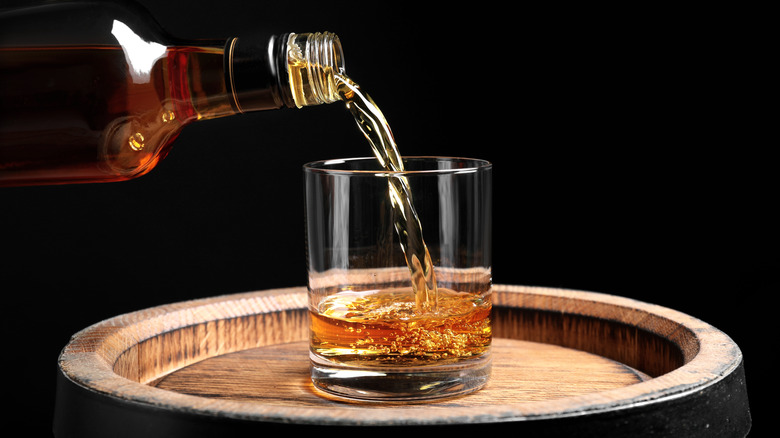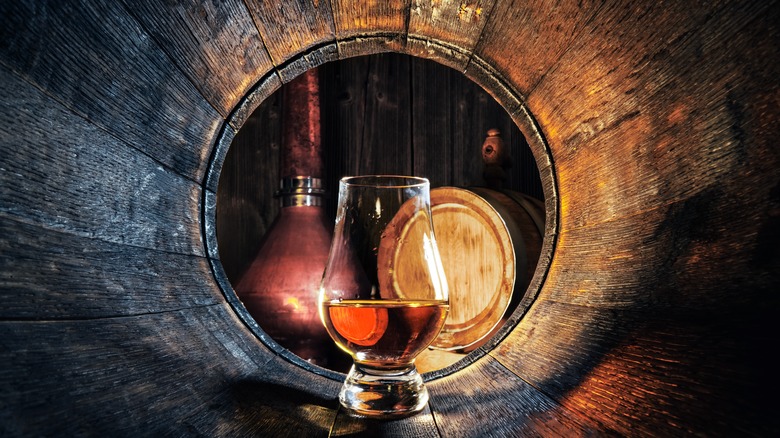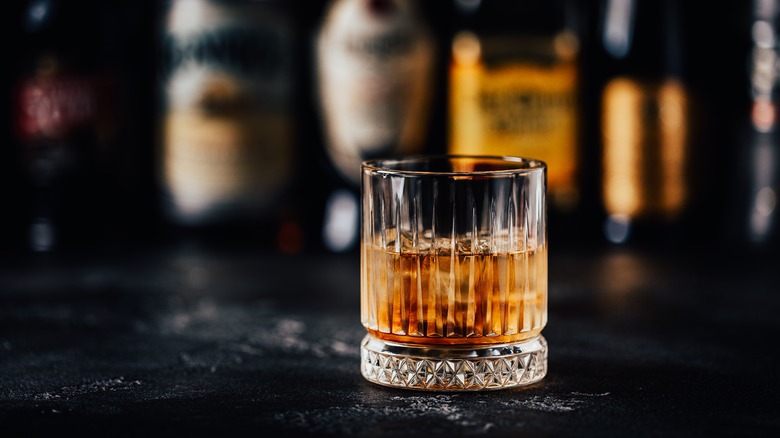Does Whiskey Actually Get Better With Age?
Whiskey wouldn't be the spirit it is without aging. Barrel aging gives whiskey its signature brown color and a significant amount of its flavor. Like with wine, the more time it spends aging, the more complex flavors it absorbs from its cask. So yes, whiskey does get better with age, but only up to a point.
Barrel aging is mandatory for most varieties, and different categories have different standards. Scotch whisky, for example, has a minimum requirement of three years spent aging in oak barrels. For bourbon, the barrels must be charred and made of new oak. For other whiskeys, there's no minimum aging period stipulated (bottles labeled as bottled-in-bond or straight bourbon whiskey are notable exceptions). In all of these cases, aging gives the spirit its unique flavor and appearance — and if you don't age whiskey at all, you have clear-colored moonshine, also called "white dog."
However, there is a point where barrel aging ceases to make whiskey better, and will instead impart unwanted flavors. For example, Eddie Russell, master distiller at Wild Turkey, tells Whisky Advocate, "When barrels age longer than 15 years, the bourbon picks up a sour or bitter taste from the barrel." That's not always the case, of course. Pappy Van Winkle's 23-year-old bourbon happens to be widely acclaimed. Even so, the bottom line is this: Aging whiskey does make it better, but more aging does not necessarily equate to better results.
What is the sweet spot for aging whiskey?
The right amount of aging not only gives whiskey its color and flavor, but it also has a mellowing effect that tempers the liquor through oxygenation. As air comes in through the pores of the barrels, it changes the spirit from a harsh, high-alcohol base into a mellower and smoother drink. Temperature is also important, as fluctuations cause the casks' wood to expand and contract, bringing the whiskey into different amounts of contact with the barrel itself.
All of this is well and good, but when does maturation peak and deterioration begin? It's hard to say with certainty. For instance, four years of aging in charred oak barrels is enough to give bourbon its color and signature flavor notes, like vanilla and caramel. Any less aging, and the color and flavor can be too light. But, beyond 12 years, the spirit can lose its amber glow, while its taste becomes overly oaky or bitter. Some labels can go for much longer than this without any adverse effects, but rarely is that the case.
Scotch's ideal time frame, meanwhile, is longer (12 to 25 years) due to the practice of aging the whisky in previously-used barrels. Barrels that aren't brand-new impart flavors at a slower rate, allowing distillers to age for more time. As with bourbon, there are exceptions. Johnnie Walker Blue Label, for example, is a blend of whiskies aged 28 to 60 years, but the whole blending part likely aids in creating a flavor that isn't off-balance.
What is whiskey like without aging?
Some whiskeys, of course, aren't aged at all. They're bottled as soon as they're distilled, without color, and without much of the flavor we typically associate with the spirit. Often called "white dog" or "white lightning," as noted by Angel's Envy, the result isn't much different than moonshine, except for the fact that it's legal. Some bourbon producers, like Buffalo Trace, actually bottle a white dog for those who want to try whiskey as it was made a few hundred years ago.
White dog has little flavor save that of its grains — in bourbon, it's mostly corn – and it has a harshness that is quite different from older, more mellowed varieties. This is typical of most very young whiskeys, in fact, as they haven't acquired more complex flavors from the barrel yet. That's why, for example, scotch has minimum aging requirements. With bourbon, the barrels are charred, a process that allows young whiskeys to more easily pick up flavors from the wood.



